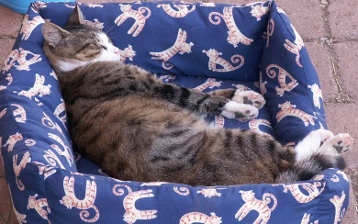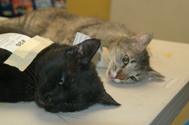The benefits of desexing
Desexing is beneficial for all cats, both cherished pets and managed cat colonies. It is also beneficial for humans by minimising cat related problems. Ideally cats should be desexed when they are 5-6 months old.
Desexing:
- Prevents the breeding of unwanted kittens
There are not enough homes for all kittens, and many end up being killed in animal shelters.

- Stops annoying mating behaviour
Such as the foul smell of spraying by toms, and cat-calling over mates at night. With females not coming into season, it elimates the many visiting tom cats that would otherwise have called.
- Stops mating fights
And the abscesses that result from bites and scratches. Desexing reduces the risk of diseases. Sexually transmitted diseases are eliminated, and cats have better immunity because they are in better condition. Females are not run down by producing and feeding kittens, and males are not run down by continual fighting.
- Stops cats from wandering in search of mates
Cats are then easier to bring inside for the night, and they are less likely to be hit by a car or to cause any disturbance in the neighbourhood.

Desexing prevents cats from being much trouble to anyone.
Unwanted kittens
Some people mistakenly think it is a good idea for a female to have one litter before being desexed. All this does is add to the already huge pool of cats looking for homes.
It has been estimated that 2 cats producing 8 kittens a year could produce 174,760 cats in 7 years even if each cat breeds only for 1 year. If cats could breed for the whole 7 years, the number of cats would be 781,250, assuming that half the kittens are female and that none of them die (1). You can see that if cats are allowed to breed it is impossible to find homes for all the kittens.

Unwanted kittens have been subjected to terrible cruelty. Some are dumped, even though dumping an animal is an offence under section 13.3(b)(iii) of the Animal Welfare Act. Some kittens have been drowned, even though the distress this causes is an offence under section 13.3(h) of the Animal Welfare Act. Dumping or drowning unwanted animals is not only cruel, it is against the law and can be prosecuted.
Many kittens and older cats end up at animal shelters. Some find homes, but the majority end up being killed. For example, in 2009-10 at the RSPCA shelter in Adelaide, 58% of the cats received, a total of 2266, were destroyed. There aren’t enough homes for all the kittens.
Don’t add to the problem by allowing your cat to breed.
References
(1) Mahlow, J. & Slater, M. (1996). Current issues in the control of stray and feral cats. Journal of the American Veterinary Medicine Association, 209: 2016-2020